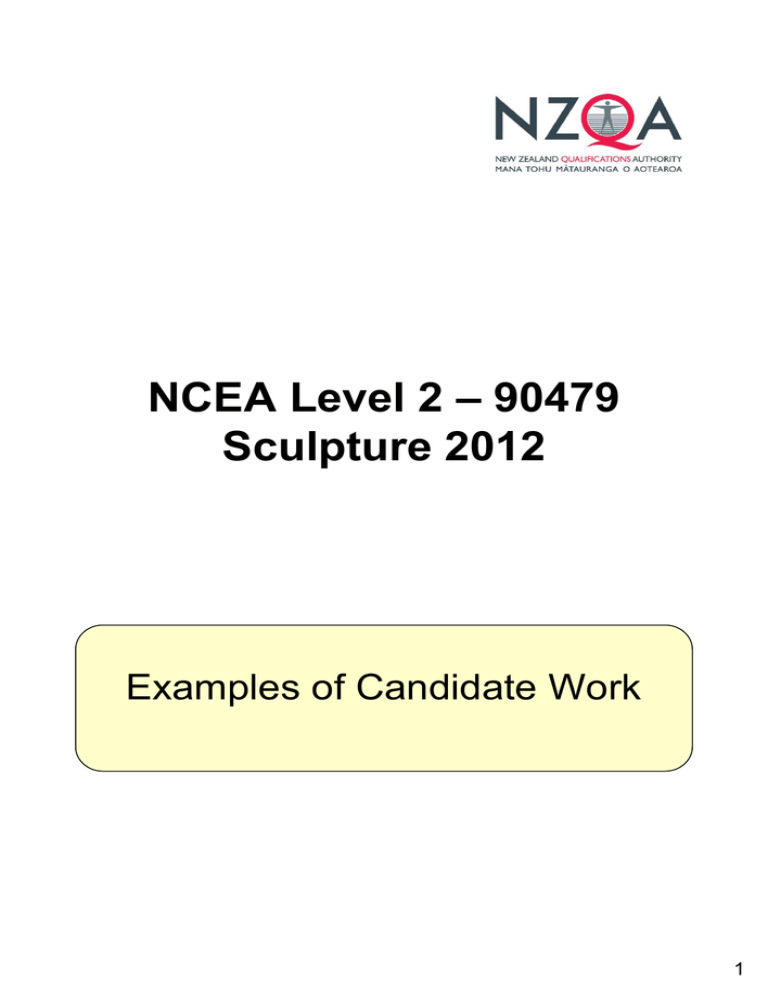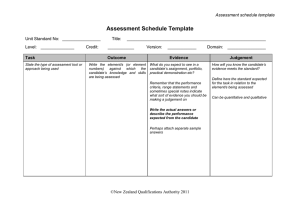presentation format (PPT, 2.2MB)
advertisement

NCEA Level 2 – 90479 Sculpture 2012 Examples of Candidate Work 1 Excellence 2 This portfolio has been verified as clearly within the Excellence grade range ‘Grass/doors’ The portfolio presents outstanding evidence to meet the criteria consistent with The New Zealand Curriculum, Learning Media, Ministry of Education, 2007, relating to the following strands in Visual Arts, Level 7: Understanding the Arts in Context; Developing Practical Knowledge; Developing Ideas; Communicating and Interpreting. The candidate actively and duly engages in sculpture making from the outset. Ideas around spilling, escaping, containment, entering and exiting are explored. A range of ideas and conventions from the likes of Brock Davis, Rachel Whiteread, Heather Ackroyd and Dan Harvey are used to critically inform the student’s own work. Fluent control of media is clearly demonstrated as materials are manipulated intelligently and skilfully. Successful outcomes are reached on every occasion. Packaging, artificial grass, pipes, plastic cups, salvaged windows and doors are critically and appropriately selected as subject matter. The student has used complex construction techniques to communicate ideas throughout the folio. There is excellent documentation of the ideas in the submission including working drawings and references that support the sculpture making. Three dimensional problems are explored and clarified with insight throughout the submission. The candidate demonstrates clear fluency and a real sense of engagement as sculptural ideas are confidently and intelligently regenerated. 3 4 5 This portfolio has been verified at the lower end of the Excellence grade range. ‘Hands-sieve’ The portfolio presents convincing evidence to meet the criteria consistent with The New Zealand Curriculum, Learning Media, Ministry of Education, 2007, relating to the following strands in Visual Arts, Level 7: Understanding the Arts in Context; Developing Practical Knowledge; Developing Ideas; Communicating and Interpreting. This submission begins by exploring concepts about the temporary nature of life, human frailty and the unexpected. A humorous approach is developed through a set of modelled body part forms and an interactive performance aspect is introduced in the ear piece and in the sequence of the figure and shadow. Panel two expands on this by continually using new references to inform the more complex sculptures that conclude the submission. A broad range of models including Robert Gober, Peter Callesen and Nele Azavedo could have been used to inform the candidate’s development. A range of technical approaches including modelling and time based sculptural practice are employed. Materials are appropriate to purpose and include polymer clay, paper, wax, flour and bark. While it is advisable to label, document and indicate some information, to move further up the Excellence grade range the candidate could have reduced the amount of notes on panel one and therefore allow more sculptural opportunities to be presented. 6 7 8 Merit 9 This portfolio has been verified at the high end of the Merit grade range. ‘Bike’ The portfolio presents sound evidence to meet the criteria consistent with The New Zealand Curriculum, Learning Media, Ministry of Education, 2007, relating to the following strands in Visual Arts, Level 7: Understanding the Arts in Context; Developing Practical Knowledge; Developing Ideas; Communicating and Interpreting. The submission starts with a valid point of entry by introducing the deconstructed object in various forms of assemblage. The introduction of boxes gives scope for development and extension. Spatial concerns are explored throughout culminating in the reconstituted bike at the end of the submission. There is a very purposeful extension of ideas presented that places the submission near the top of the Merit grade range. Understanding of established sculptural conventions is evident as artists like Gabriel Orozco and Tony Cragg are used by the student as models for development. It is clear the candidate has engaged in a range of sculpture-making processes and methods and has used three dimensional thinking to solve sculptural problems. The submission has a clear sense of purpose as it progresses coherently towards the endpoint that integrates the students own ideas with those learnt from artistic practice. To move to Excellence the candidate could have clarified and regenerated ideas more expansively and reinvented some of the eloquent discoveries from the beginning of the submission with more spatial manipulations. 10 11 12 This portfolio has been verified at the low end of the Merit grade range. ‘Jigsaw/Cubes’ The portfolio presents sound evidence to meet the criteria consistent with The New Zealand Curriculum, Learning Media, Ministry of Education, 2007, relating to the following strands in Visual Arts, Level 7: Understanding the Arts in Context; Developing Practical Knowledge; Developing Ideas; Communicating and Interpreting. This submission explores ideas of time and pastimes that are referenced by nature [leaves, seasons] and games [cards, Rubik’s cube, puzzles, shapes]. The proposition that is established at the beginning of the submission creates possibilities for extension of ideas. A range of models that could have included Zadok Ben David, Tom Friedman, Lorenzo Duran and Alistair Heseltine have been used to inform the student’s development. Panel one explores simple silhouettes, surfaces and edges that allude to ideas of growth, opposites and individualism. As the folio progresses, a shift from linear and two dimensional work to exploration of three dimensional forms with an emphasis on vertical proportions is developed. These ideas are then extended at the bottom of panel two as 2-d and 3-d ideas are combined. Formal elements such as the grid and repetition are explored in a number of ways across the submission from the stack of autumnal leaf cubes through to the Rubik’s cube and puzzle work. The jigsaw develops the idea of individual elements becoming united to form a whole. To move further up the Merit grade range, the facility and technical skill employed in construction would need to be more assured with particular attention given to detail. More careful attention to the editing and ordering of works across the folio may have allowed for an exploration of new possibilities and some regeneration to occur. 13 14 15 Achieved 16 This portfolio has been verified at the high end of the Achieved grade range. ‘Flowers/leaf’ The portfolio presents sufficient evidence to meet the criteria consistent with The New Zealand Curriculum, Learning Media, Ministry of Education, 2007, relating to the following strands in Visual Arts, Level 7: Understanding the Arts in Context; Developing Practical Knowledge; Developing Ideas; Communicating and Interpreting. This submission begins with skilful observational studies of natural materials and investigates the properties of these in small temporary works. The student engages in a ‘sculptural’ debate that focuses on relationships between the natural and artificial worlds. Working closely with models like Andy Goldsworthy, Nikki Hastings-McFall and Peter Madden, the candidate generates and develops ideas by placing natural and artificial plant forms into different contexts. Construction techniques are elementary but appropriate to the purpose of the investigation. Three-dimensional collage techniques, the use of natural materials and resurfacing, clearly reference the models investigated. Materials are re-contextualised with understanding and presented systematically throughout the submission. The strength of the submission can be seen on panel two where three sequences of work are developed from ideas generated earlier. There is evidence of a systematic approach through the careful editing and ordering of the work. The candidate attempts to extend ideas but needed to show more evidence of purposeful decision making in panel two based on the earlier preliminary sculptures to move into Merit. 17 18 19 This portfolio has been verified at the lower end of the Achieved grade range. ‘Lightbox’ The portfolio presents sufficient evidence to meet the criteria consistent with The New Zealand Curriculum, Learning Media, Ministry of Education, 2007, relating to the following strands in Visual Arts, Level 7: Understanding the Arts in Context; Developing Practical Knowledge; Developing Ideas; Communicating and Interpreting. The initial proposition for this submission involves the use of light, boxes and text taken from literature and newspaper. The candidate appears to be directing our attention to the tension that arises between the real and imagined worlds. This idea is explored in a number of ways on panel one where the candidate collages text onto the surface of box installations, alters the surface of books and uses newspaper to create a context for the assemblages. The use of a camera and fairy lights in the assemblages builds on the idea of an imagined world. The candidate appears to be thinking about modes of perception although this is not always presented convincingly. Christian Boltanski and Eve Armstrong appear to have been referenced as the candidate moves from using the box as an assemblage to working with it as an installation using construction materials and tape. The candidate could have moved further up the Achieved grade range by focussing more on the conceptual aspects of the proposition, by organising work more sequentially and developing sculptural making techniques further. Candidates also need to be reminded that producing good quality photographs of work is important in presenting sculptural ideas. 20 21 22

